Roadbuilding: Keeping track
08 January 2019
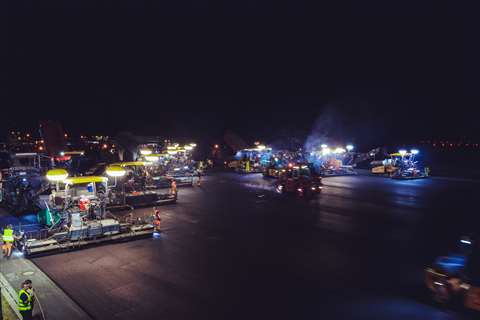
Frequent re-planning, scarce personnel and material resources, and increasing cost pressure are major challenges facing road construction companies – and the requirements are constantly escalating. Extensive installation and logistics concepts, as well as documentation of the construction process, are increasingly demanded.
The aim is to ensure homogeneous and efficient installation within the specified time and cost schedule, and digitalisation offers opportunities to meet these requirements by increasing productivity.
To this end, Volz Consulting supports construction companies with its software solution BPO. It is in widespread use in Germany, according to contractor Porr Oevermann, which started using the software in 2017.
With BPO, the entire roadbuilding process, from costing to site management, can be administered using the modular range of functions provided.
Since Porr started the company-wide rollout of the solution in 2017, about half a million tonnes of asphalt have been planned and controlled with BPO in real time.
Support from BPO was said to begin in the planning phase with the processing of installation data. All project participants are involved from the start, making it possible to identify potential issues early on and act upon them in good time, according to Porr.
Paving parameters, such as paving speed, mix requirements or the number of trucks, are calculated in BPO.
One example of several major projects Porr has already completed with BPO is the restoration of the A44n Garzweiler in connection with the A44/A46 motorway junction in Germany, which required 150 trucks to be orchestrated and 680 tonnes of asphalt to be mixed per hour by six different mixing plants. In total, more than 100,000 tonnes of asphalt were paved in six weeks.
Elsewhere in Germany, when it came to placing dual-layer concrete on the A7 widening project between Hamburg and Bordesholm, a Wirgen paving train, comprising two SP 1500 slipform pavers and the TCM 180i texture curing machine, played a key role.
The 60km stretch of road was being widened from four to six lanes – in some places, eight lanes.
Steel-Reinforced paving
With the aim of creating a pavement that would offer a high degree of driving comfort while withstanding the loads of heavy-goods traffic, the motorway consortium Via Solutions Nord and the joint venture ARGE A7 Hamburg-Bordesholm opted for steel-reinforced concrete paving with an exposed aggregate concrete surface. It commissioned BT Beton-Technik to carry out the work.
As the first paver advanced, its inset mould laid the concrete slab at 14.5m wide and 23cm thick. A total of 41 curved electric internal vibrators ensured optimum material compaction by means of high-frequency vibrations.
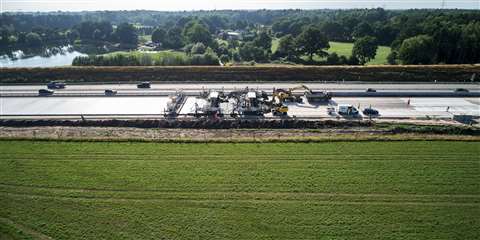
Dowel bars were inserted into the fresh, pre-compacted bottom-layer concrete at 25cm intervals parallel to the direction of travel and tie bars were inserted transverse to the pavement.
The top-layer concrete was simultaneously loaded by excavator into the receiving hopper of the belt conveyor, transported over the top of the first SP 1500 and deposited directly on the bottom-layer concrete in front of the second SP 1500.
The second machine then compacted the material by means of 29 electric T-vibrators while paving it in a 5cm-thick layer
In this way, the duo from Wirtgen paved some 4,000m³ of concrete per day.
The TCM 180i self-propelled curing unit, followed hot on the heels of the pavers. With working widths up to 18m, it was said to be an ideal team mate for the two SP 1500 pavers.
Its task was to spray a combination of anti-evaporation agent and surface retarder onto the new concrete pavement. The anti-evaporation agent protected the fresh concrete from premature drying during its hardening phase, while the retarder enabled the surface mortar to be swept off, exposing the high-grade broken aggregate in the top-layer concrete. This gave the concrete pavement the required peak-to-valley depth and lasting grip.
Finally, another curing agent was sprayed over the exposed aggregate.
Across the North Sea, in the UK, the country’s largest road upgrade has reached its halfway point. The £1.5 billion (€1.68 billion) A14 Cambridge to Huntingdon improvement scheme covering a 34km stretch of road began in 2016 and is on target to be completed by the end of 2020.
Since work started, more than 8 million working hours have gone into the project and 8 million m3 of earth have been moved across the site, representing 80% of the total amount of material that will have to be moved. Nine new bridges will have opened to traffic by the end of the year and construction is underway on 25 more.
David Bray, Highways England project director for the scheme, said, “Most days we have up to 2,700 staff working across more than 20 miles to build the new roads and bridges that are needed, in addition to all of the environmental measures we are implementing. This is the biggest roadbuilding project currently taking place in the country and yet drivers will only see around a quarter of it from the existing road at present.”
The stretch of road is being upgraded to three lanes in each direction, including a brand new 27km bypass south of Huntingdon, with four lanes in each direction between Bar Hill and Girton.
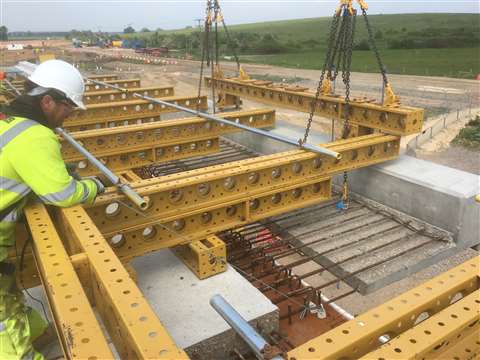
EFCO helped to stitch together the pre-cast elements of the River Great Ouse Viaduct in the UK
The free recovery service was said to have responded swiftly to every incident within the existing roadworks, recovering more than 700 broken down vehicles, with 95% of these cleared within an hour, and 184 cleared within 30 minutes.
Along the way, the team of 250 archaeologists involved in the scheme have investigated 33 sites across 360ha, uncovering finds such as a Roman camp, an abandoned medieval village and a variety of Ice Age animals, including a woolly mammoth from 130,000 years ago.
All electricity used in the project has come from renewable sources, and some 866,000 plants are being planted alongside the new A14.
The team has won eight industry awards for innovative working, including Best Construction Project to Work On and an RoSPA Gold Health and Safety Award.
One of the 34 main bridges in this scheme is the 750m-long River Great Ouse Viaduct, with its 6,000-tonne steel structure. The viaduct is 85% complete and US-based EFCO has been helping with the installation of its pre-cast units.
Offsite construction
The increasing popularity of off-site construction techniques, far from marginalising falsework and formwork companies, is providing plenty of work for them – if not more, according to EFCO. This is because methods for the placement and support of pre-cast units on site often require at least as much temporary work as an equivalent cast-in-place solution.
The River Great Ouse Viaduct features a composite deck consisting of heavy steel members with pre-cast slabs and parapet beams. The pre-cast elements are then connected to complete the deck with an in-situ stitch pour.
The challenge for EFCO was to design and supply a system of beams that could support the 6.5-tonne pre-cast units as they rested on the edge of the steel before the final stitch pour was executed.
Adding to the complexity of the job, the bridge had a tight tolerance and complex geometry. So, EFCO’s solution required suitable adjustment in all three axes at the key setting out locations, and the beams had to be pre-set to allow for a calculated deflection under load once the crane was released.
Working in close collaboration with the project’s contractor and sub-contractor during planning, EFCO developed a two-stage approach.
First, adjustable beam members were provided and attached to the pre-cast units before they were transported to the project site. The beams had fine-adjustment threaded units that allowed for each member to be set to the correct angle before being lifted into position on the bridge. At the same time, twin support beam members were attached to the pre-cast slab on the bridge deck and adjusted to provide accurate bearing locations for the landed units.
Once each unit was placed, the crane was released and checks were made on the accurate final position of the pre-cast concrete. The support members then remained in place until the reinforcement for the stitch pour had been placed, the concrete was pumped and adequate strength was achieved for the structure to be fully self-supporting.
In all, 252 pre-cast units weighing a total of 1,638 tonnes were placed on the bridge using 40 sets of support beam assemblies that were re-used and adjusted for geometry as they cycled down the structure.
In Austria, Asfinag – the company that builds and maintains the country’s motorways – is upgrading the Gleinalm Tunnel as part of its traffic strategy campaign. The road tunnel is Austia’s third longest, at 8km in length.
It involves the excavation of a second, parallel tube, full-scale renovation of the original tunnel and construction of special portal structures at both ends, for which Doka has been tasked with the formwork.
The portals have a complex geometry that combines architectural and functional features, while satisfying requirements for tunnel ventilation, snow-clearing operations and the bright/dark adaptability of the
human eye.
To keep traffic moving on the A9 motorway, the first phase involved the excavation of the new east tube and the building of some sections of the north and south portals. Since its completion, this tube has carried all the two-way traffic while the original west tube was closed for major renovation and construction of the rest of the new north and south portals.
For the portal galleries of the east and west tubes, the crew’s first task was to construct the dividing walls between the two wings. The wall formwork was stepped Framax Xlife, with trapezoidal timber fillers as connectors to form the sharp kinks.
Reduced number of steps
Each section of the complex geometry was different, so Doka’s planning made the gangforms as big as possible to reduce the number of work steps involved. Then the gapped outer walls of the portal galleries were formed and poured. The outward lean of the outer walls was 17° at the steepest points, so reliable propping was essential. For this reason, Eurex 60 floor props were used.
With the aim of helping roadbuilding companies to make efficiency gains and tackle problems such as skilled labour shortages, OEMs are constantly introducing new equipment that boasts higher productivity, less maintenance or simpler operation.
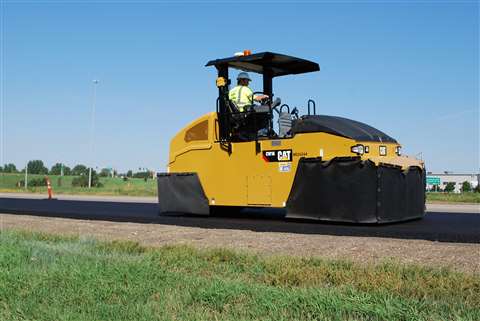
Caterpillar, for example, has introduced the new Cat CW16 pneumatic rubber-tyred compactor, which was said to have been designed for efficient performance on such projects as highways, city streets, country roads and industrial sites.
The compactor, which features two different wheel configurations and can be used with different types of ballast, is intended for use on granular materials and all types of asphalt-mix designs.
The standard nine-wheeled model has a 1,754mm compaction width, while the optional 11-wheeled model has a 2,132mm compaction width.
Depending on the ballast used – whether it is water, sand, steel or a combination of these – the operating weight of the CW16 varies from a 5,200kg base configuration to an approximate maximum weight of 15,000kg for the nine-wheeled configuration and 14,900kg for the 11-wheeled configuration.
The weight per wheel can be varied from 580kg to 1,670kg for the nine-wheeled model and from 480kg to 1,350kg for the 11-wheeled model.
Oscillating front wheels assist in compacting soft voids across the entire machine width, and each wheel is equipped with self-adjusting scrapers, while a water-spray system prevents material from adhering to the surface of the wheels.
Meanwhile, Ammann has launched its new ARX 91 articulated tandem roller, which was said to be able to compact thin and thick asphalt layers in fewer passes.
Dhruv Patel, global product strategy for machines at Ammann, said, “A combination of drum dimensions, frequencies and amplitudes provide productivity and flexibility on a variety of jobsites.”
He added that the ARX 91 could achieve the same compaction as heavier competitive models while at the same time consuming less fuel and costing less to maintain.
At an operating weight of 9 tonnes, the ARX91 is designed for medium and large jobsites, from car parks to infrastructure projects.
It uses a Cummins Stage 3A-compliant engine, which is located in the rear of the machine to drive vibration away from the operator and towards the compaction target.
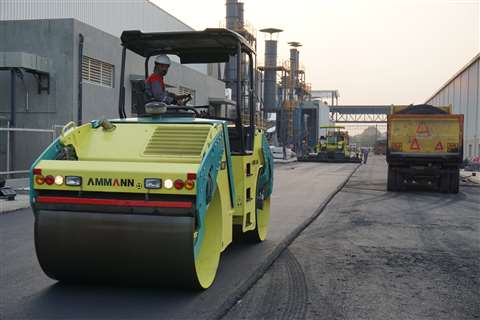
The machine’s hydraulic system, traction control and speed sensors were said by Ammann to enable smooth starts and stops that improve asphalt mat quality, and the machine’s tight turning radius improves operator control and manoeuvrability.
Ammann Compaction Expert (ACE), the company’s proprietary intelligent compaction system, is available as an option to monitor density and provide feedback, helping to reduce the number of passes made. It was also said to eliminate both over-compaction and under-compaction, and cut down on fuel consumption.
Larger applications
Volvo Construction Equipment (CE) recently introduced its new P6820D and P7820D ABG tracked pavers for the building of new roads and larger maintenance applications.
Mahadevan Natesan, product manager for road machinery within Volvo CE’s EMEA (Europe, Middle East and Africa) sales region, said, “The new D-Series pavers put operators in control with Volvo’s technologically-advanced features designed for simple operation and maximum efficiency. The next generation EPM3 control system and adaptive Eco mode boost long-lasting paving performance while reducing fuel consumption.”
He added that Pave Assist could be used to unlock the full potential of the machines.
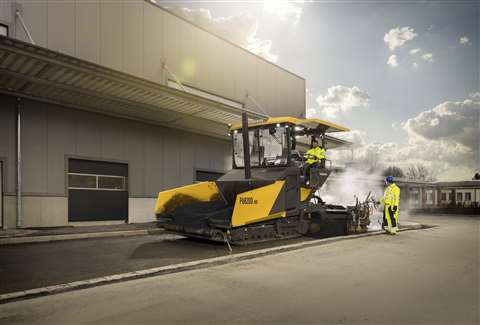
Depending on the application and conditions, customers have the choice of either single or double tamper screeds to create a smooth, uniform surface, and the built-in adaptive power feature was said to give operators more power while consuming less fuel.
From the operator platform, all-round visibility is provided around the paver, hopper, auger channel and screed. Also, optional LED lights can help operators perform in low-light conditions.
GOMACO has digitally enhanced its GT-3600 curb and gutter machine to create the new Xtreme GT-3600.
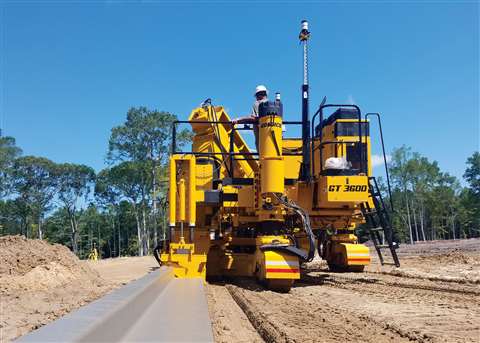
The GT-3600 was said to be the first three-tracked machine to slipform a 610mm radius, and now, with the Xtreme package, tight radius paving is easier and more efficient than before, according to GOMACO.
The Xtreme package adds the company’s G+ radius software with slew drives, smart-sensored hydraulics and intelligence to the original GT-3600.
Xtreme steering and intelligence has been added to each of the machine’s three tracks and includes rotary-sensored slew drives, sensored all-track steering and all-track positioning, and smart hydraulic cylinders.
The tracks can rotate further than before and the smart cylinders allow the G+ control system to know the exact position of each of them so it can make steering adjustments as necessary.
From adjusting the screed to retrieving paving programmes, paver operators must know exactly which operating function to use and when, in order to achieve optimum paving results
To help them, Vögele has developed an app for its ErgoPlus 3 operating concept.
Martin Hilken, product marketing manager at Vögele, said, “This app complements the operator training courses available at our training centres and offers users a tool with which they can selectively refresh and deepen their knowledge.”
All the functions of the paver operator’s and the screed operator’s consoles are conveyed in a visual and practical way by means of short animations. Step-by-step videos give users concise demonstrations of entire work steps such as setting up the screed or requirements such as varying pave widths, as well as comprehensive automatic functions. These are accessible through the free app at any time on a PC, tablet or smartphone.
For surveying tasks in the building of roads, the company TinyMobileRobots now offers the TinySurveyor. The small, wheeled device is designed to make stake-out work more efficient.
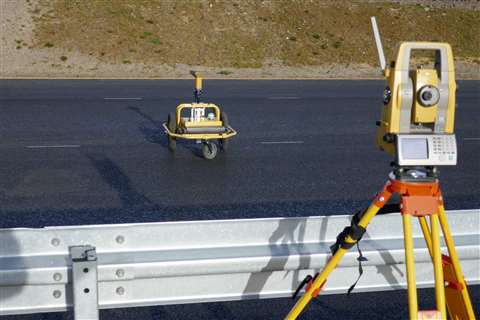
It can integrate with a customer’s existing GNSS (Global Navigation Satellite System) equipment, or, in areas with restricted access to GNSS, it can be connected with a total station for height measurements.
A layout design can be uploaded in CSV or DXF formats via the USB port.
TinyMobileRobots said one application in which many of its customers found the robot to be particularly efficient was the pre-marking of road lines. With minimal setup, the device drives autonomously and defines points along defined lines with an accuracy of between 1 and 2cm. This can vary depending on location, but in open motorway projects it was said that a higher degree of accuracy could be expected.
With a fully-charged battery, the TinySurveyor can work continuously for about eight hours, according to the company.




